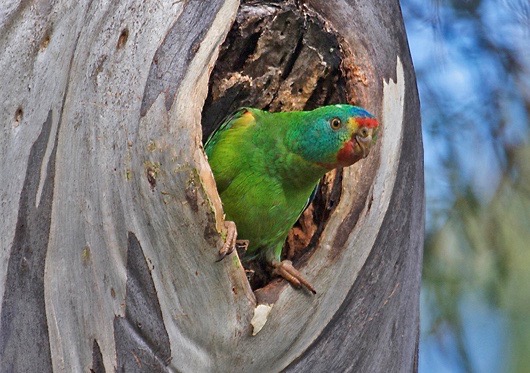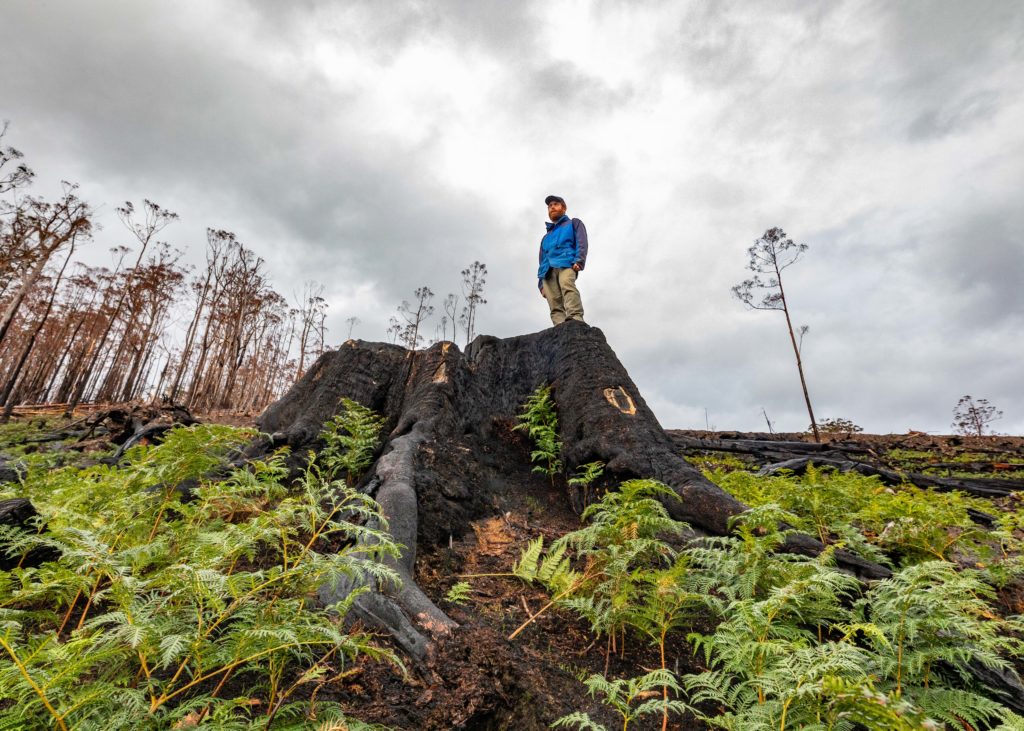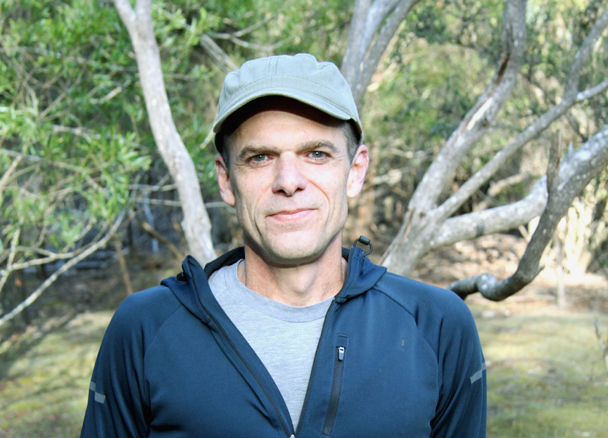‘Not acting is a decision’: Scientists warn failing system drives wildlife to extinction

Leading scientists have described a failing system of wildlife protection in Tasmania, with government staff feeling pressure from officials to change advice to allow vital habitat to be logged and fewer than 15 per cent of threatened species being actively monitored.
Matt Webb, who worked at the state government threatened species section from 2003 to 2015, said senior officials repeatedly expected him to alter his scientific opinion, mostly on whether it was safe to log habitat of the critically endangered swift parrot.
Since leaving the public service and joining the Australian National University’s (ANU) Difficult Bird Research Group, Webb has been asked for advice on whether proposed logging coupes were safe to log, but said his recommendations were regularly ignored.
Tasmanian Inquirer last year visited forest near Barnback Road, in the Huon Valley, where Webb found swift parrot nests in 2015 and recommended against logging. The coupe had been clearfelled in the summer of 2018-19.
The swift parrot is a migratory species that breeds in Tasmania, and has a lifespan of about 15 years. Numbers are estimated to have fallen from about 8000 breeding pairs to fewer than 1000 over the past decade as its breeding habitat has reduced. Peer-reviewed research has estimated it could be extinct by 2031 on its current course.
“I felt pressured to change my advice on coupes... and not follow the science.” – Matt Webb, ANU
Webb said it was emblematic of a government and bureaucratic culture that prioritised forestry over nature, and had pushed the species towards extinction.
He made the claim in evidence to a hearing of a Greens-led Senate inquiry into Australia’s faunal extinction crisis in Hobart in February 2019. It was not reported at the time.
He told the inquiry: “Effectively, I felt pressured to change my advice on coupes – logging coupes, in particular – and not follow the science that we were undertaking. As a scientist, you can’t do that.”
“It was also difficult after leaving, or while being on leave without pay, being threatened with a breach of the code of conduct, and it was simply over publishing scientific papers on our research, which seems like an odd thing to be threatened with.”
‘The new government won’t stand for it’
In a later interview with Tasmanian Inquirer, Webb said the pressure and stress he faced while working at the Department of Primary Industries, Parks, Water and Environment (DPIPWE) made his job impossible, leading to him taking leave without pay and eventually resigning.

Destruction of swift parrot habitat in Barnback logging coupe, Huon Valley 2019. Image: Dan Broun
He said the issue escalated shortly before the 2014 election, when the Will Hodgman-led Liberal party took power. Senior bureaucrats told him shortly before the election that the goal of his work would change from maximising available breeding habitat for swift parrot to “minimising habitat loss where practicable”, a shift he saw as requiring him to prioritise forestry needs.
Webb said in a separate meeting shortly before the election one bureaucrat told scientists working on threatened species they “should go and focus on something else you can make a difference on because you’re not going to do it here” after the expected change of government.
“He just said ‘the new government won’t stand for it’,” he said.
He said the number of state government staff working on threatened species gradually reduced from about 15 to less than two full-time equivalent positions, responsible for giving advice on the state’s about 700 threatened species.
“If you do a breakdown of that, it’s not much to go around,” he said.
‘We seem to be incapable of making clear decisions’
The swift parrot has been listed as threatened since the introduction of the national Environment Protection and Biodiversity Conservation Act 20 years ago. Despite the listing being meant to trigger its protection, its status has declined from vulnerable to critically endangered over that time.
Webb has worked on threatened species conservation for 20 years, including 16 years monitoring and researching the swift parrot.

Australian National University scientist with the Difficult Bird Research Group, Matt Webb. Photo: Adam Morton
Peer-reviewed studies have found the bird’s decline has coincided with a significant decline in the flowering blue gum and black gum it relies on for food, and large trees with hollows, usually hundreds of years old, that it uses for nesting.
Most of the parrot’s northern Tasmanian habitat has been lost, leaving a few areas in the east and south. The bird is also under pressure from a predator, the sugar glider, in most of these forests.
Webb said swift parrots were unusual among threatened species in Tasmania in that there was a wealth of published science about how poorly they were faring. He said there had been at least three attempts to bring in conservation plans including a reserve system to protect remaining swift parrot breeding habitat. All failed.
“What chance do the other 700-odd threatened species in Tasmania have that we know very little about?” – Matt Webb, ANU
Scientists say this is at least in part due to the 1997 Tasmanian Regional Forestry Agreement between the federal and state governments, which gives the timber industry precedence over environmental concerns on land set aside for logging.
“We seem to be incapable of making clear decisions that are required to secure the species,” Webb said.
He told the hearing: “I’d like to make the point that not acting is still actually a decision.
“If we can’t achieve an effective conservation outcome for a species that we know so much about, and we have already had so many attempts at trying to sort out this issue – it is a difficult issue – what chance do the other 700-odd threatened species in Tasmania have that we know very little about?”
Compromising to extinction
Clare Hawkins, a conservation biologist, worked on the state Save the Tasmanian Devil Program for four years before joining Webb in the threatened species section from 2008. She stayed until 2017.
She was responsible for threatened animal species, giving advice on the conservation and recovery of threatened species to parks management, regulators and the public.
Now working for the not-for-profit Bookend Trust, she has estimated Tasmania has monitoring programs for fewer than 15 per cent of its threatened species.
She said while the impact of individual development applications may be small in isolation, the cumulative impact of multiple developments could be significant and there was nothing in place to measure them.
“It is bloody frustrating,” she said. “We literally don’t know the impact of the effectiveness of any conservation we are doing because we are monitoring so few threatened species.”
“Some might have disappeared, some might be doing fine. How would we have any idea at all?”
“The attitude is to find a compromise, but you can’t keep compromising with threatened species.” – Clare Hawkins, Bookend Trust
Hawkins gave examples of species that were inadequately monitored: five species of burrowing crayfish, some of which were having houses approved above their habitat; 40 species of freshwater snail, often living in a tiny area on private property, with a landowner who had no idea they were there; the new Holland mouse, which had not been seen for years and could have gone extinct in Tasmania; several species of antechinus, a mouse-like marsupial that are not listed as threatened in part because no-one knows how many there are.
A plant known as the graveside leek-orchid, which was only known to be found in Campbell Town, was likely to have been driven to extinction because no-one intervened. “All people needed to not do was mow the area that had this tiny number of leek-orchids in Campbell Town and there just wasn’t enough government support behind it,” Hawkins said.
She said the failure across species was “partly due to a lack of resources, but there may have also been a lack of will”.
In contrast to Webb, she said she was not pressured to change scientific advice. But she said her recommendations about what was necessary to protect species had often been ignored.
She said when she confronted one of her superiors about why a development was approved against her advice she was told: “It’s my job”.
“People would often say ‘well, meet me halfway’. But when you’re working as a scientist you’re not really playing a negotiating game, you’re saying what’s required,” she said.
“The attitude is to find a compromise, but you can’t keep compromising with threatened species. They’re already threatened. They have nowhere to go.”
Government response
A government spokesman said threatened species management was “part of the daily business” for many areas of DPIPWE and other agencies including police, the fire service and the Department of State Growth.
He said DPIPWE had the Tasmanian devil program that used to employ Hawkins, a marine conservation program and a dedicated program for the critically endangered orange-bellied parrot.
“Furthermore, Parks and Wildlife staff play a vital role in managing habitat for threatened species across our reserve estate,” the spokesman.
“We have multiple compliance teams that undertake activities to protect our threatened species by investigating and prosecuting the illegal taking of listed plants and animals, and the introduction of exotic species that could impact on our native species. They work closely with Tasmania Police and compliance officers in other agencies, all of whom play an important conservation role.”
On swift parrots, the spokesman did not respond directly to the claim bureaucrats had pressured scientists to change their advice.
He said DPIPWE had taken conservation measures including working with researchers to identify and take into account breeding locations, programs to control invasive rainbow lorikeets, co-operating with the forestry industry and regulators to use new technology to identify and manage places critical to the species, funded a $150,000 project to trial sugar glider trapping methods and worked with the Commonwealth on conservation tools including a swift parrot recovery plan. The plan is being reviewed by the federal government.
He held several senior roles for The Age in Melbourne, and has reported and written for the Sydney Morning Herald, ABC, BBC and Nature, among others. He has won several industry awards, including the United Nations Association of Australia media award for environmental reporting three times.
 @adamlmorton
@adamlmorton